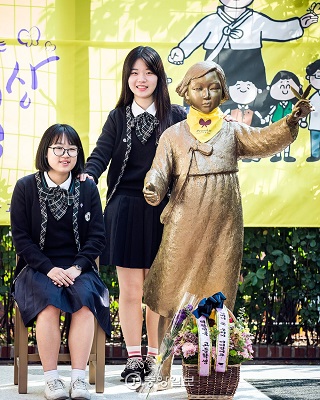Students build a comfort girl memorial

Two Ewha Girls’ High School students, Yoon So-jeong, left, and Kwon Yeong-seo, pose next to the bronze statute of a girl representing the victims of Japan’s wartime sexual slavery, made with money they raised, in front of the Franciscan Education Center in Jeong-dong, central Seoul, Wednesday. [Park Jong-keun]
The face shows a girl no older than a teen. She symbolizes the tens of thousands of girls and young women forced into sexual slavery by the Imperial Japanese Army during colonial rule and World War II, who are euphemistically referred to as comfort women.
There are several such “Peace Monuments” representing the comfort women victims globally, including as far as California, but this particular statue was created through the efforts of two 18-year-old juniors in high school.
Kwon Yeong-seo and Yoon So-jeong of Ewha Girls’ High School shared with the JoongAng Ilbo how they got involved in the project.
“Last year, by chance I attended the weekly comfort women demonstration outside the Japanese Embassy in Seoul and heard the stories of the elderly victims in person, which felt like a blow to the stomach,” Kwon said. “We thought that if young people like us take action, adults may also be moved to become more involved as well, so we started the comfort women statue project.”
“These grandmothers endured a terrible thing when they were our age,” Yoon added, “so our hearts were struck by the deep pain and sadness that they must have felt.”
The two students started off by posting handmade posters around their school asking for donations. The posters read, “Students who want to take part in building a comfort women statue, please donate 5,000 won.”
They sent out appeals over Facebook to students and parents alike.
They eventually collected 5 million won ($4,380).
With that money, they made butterfly badges, symbolic of the comfort women victims, selling them for 2,000 won.
They sent letters to other high schools about their cause. In response, 53 schools purchased 16,000 badges. The badges also sold well over the Internet.
“Some people would buy one badge and give us 20,000 won, telling us, ‘Use the change well,’” Kwon recalls.
Eventually, they raised 30 million won.
The next step was to find a site to be home to the statue.
They first sought space in front of the old Seoul City Hall building. Seoul Metropolitan Government officials told them that their intentions were good, but giving permission to one statue would create a flood of similar applications.
They tried for a space outside the National Tax Service’s annex building in Namdaemun, but the administrative process to get permission was going to take a long time.
Ultimately, the Franciscan Education Center gave them the okay to put the statue on its land. The center held an administrative meeting, and the statue gained a home.
The bronze statue of a girl in hanbok with arms outstretched was unveiled on Tuesday. Kwon and Yoon insisted that the statue of a younger victim have a sense of vigor and energy, unlike similar statues that came before, which are usually sedate and sad. The sculptor of the piece is Kim Seo-kyeong.
The two girls were aware that the comfort women issue was a major topic in the summit meeting between Korea and Japan’s leaders on Monday. They hope for some resolution near the horizon and a better attitude from Japan.
“It is right for the younger generation to know the faults in their own history,” Yoon said of the unresolved nature of the comfort women issue and Japan’s reluctance to apologize. “It’s not something for another country’s people to resolve for them, is it?”
“Not apologizing properly right now will create a bigger burden for the future generation,” Kwon said. “This is not something that we can just brush under the carpet. If the issue is not solved now, it will become a poison that will return later on.”
BY YOO JEE-HYE [kim.sarah@joongang.co.kr]










with the Korea JoongAng Daily
To write comments, please log in to one of the accounts.
Standards Board Policy (0/250자)